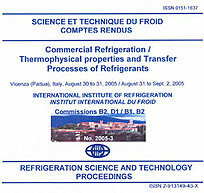
Document IIF
Refroidisseur à absorption et pile à combustible : un système intégré pour les applications commerciales.
Fuel cell absorption chiller integrated system for commercial applications.
Auteurs : LAZZARIN R., MINCHIO F., NORO M., et al.
Résumé
Fuel cells have recently undergone relevant technological developments. Their high electrical efficiency (that does not decrease under partial loads) is particularly appreciated. Major investment and research from industries and universities are directed to distributed cogeneration, besides automotive applications. The article reports on the description, analysis and results of simulations of a fuel cell absorption chiller/heat pump integrated system for commercial air conditioning. The fuel cell type analysed is a liquid cooled proton exchange membrane fuel cell. The thermal levels of heat recovered from the fuel cells are extremely favourable to couple with a lithium bromide absorption chiller. The integrated system performances in department store or shopping centre air-conditioning systems are definitely interesting from both energy and pollution points of view. This study investigates the energy performance of this system in a commercial application by means of a transient numerical simulation model (Trnsys) and a MatLab-Simulink simulation model, compared with a traditional system.
Documents disponibles
Format PDF
Pages : 2005-3
Disponible
Prix public
20 €
Prix membre*
Gratuit
* meilleur tarif applicable selon le type d'adhésion (voir le détail des avantages des adhésions individuelles et collectives)
Détails
- Titre original : Fuel cell absorption chiller integrated system for commercial applications.
- Identifiant de la fiche : 2006-0919
- Langues : Anglais
- Source : Commercial Refrigeration. Thermophysical Properties and Transfer Processes of Refrigerants. Proceedings of the IIR International Conferences.
- Date d'édition : 30/08/2005
Liens
Voir d'autres communications du même compte rendu (140)
Voir le compte rendu de la conférence
Indexation
-
Thèmes :
Autres équipements de conditionnement d'air;
Cogénération, trigénération;
Systèmes à absorption et adsorption;
Autres systèmes à économie / récupération d'énergie - Mots-clés : Application commerciale; Refroidisseur; Système à absorption; Simulation; Pile a combustible; Performance; Conditionnement d'air; Eau-bromure de lithium; Cogénération
-
Case study: Glaxo Wellcome.
- Auteurs : TOZER R.
- Date : 2001
- Langues : Anglais
- Source : Ab-sorption machines for heating and cooling in future energy systems. Workshop proceedings.
Voir la fiche
-
Cogeneration power and cooling for the US army ...
- Auteurs : PATIL A. S., CALKINS F., SIFER N.
- Date : 01/08/2004
- Langues : Anglais
- Source : Natural Working Fluids 2004: 6th IIR-Gustav Lorentzen Conference
- Formats : PDF
Voir la fiche
-
Absorption chillers integration in a combined h...
- Auteurs : BRUNO J. C., FERNANDEZ F., CASTELLS F.
- Date : 17/09/1996
- Langues : Anglais
- Source : Ab-sorption 96. Towards sustainable technologies. Proceedings./ Ab-sorption 96. Vers les technologies durables. Comptes rendus.
Voir la fiche
-
Efficient use of waste heat from combined heat ...
- Auteurs : WU S., EAMES I. W.
- Date : 24/03/1999
- Langues : Anglais
- Source : Proceedings of the International Sorption Heat Pump Conference.
Voir la fiche
-
Status of fuel cell system for combined heat an...
- Auteurs : ELLIS M. W., GUNES M. B.
- Date : 12/01/2002
- Langues : Anglais
- Source : ASHRAE Transactions. 2002 Winter Meeting, Atlantic City, New Jersey. Volume 108, part 1 + CD-ROM.
Voir la fiche
